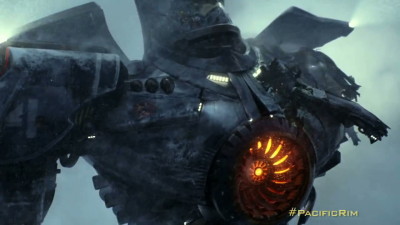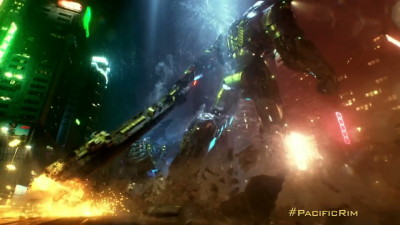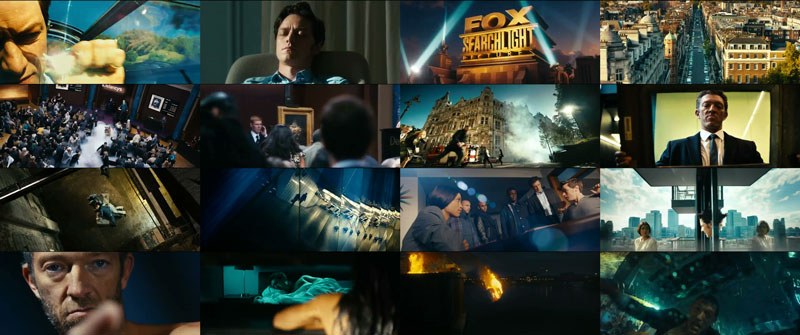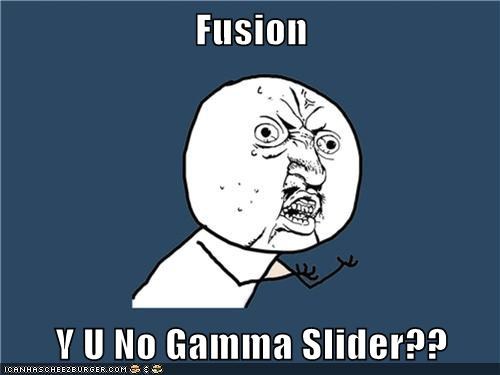Pacific Rim Rocks
I really enjoyed Pacific Rim. Here’s what they did right compared to other action movies of that genre:
The story may be simple but it’s refreshing to have a movie that is not a “dark and gritty” remake of something. It’s a can-do action movie with an atmosphere of movies like Top Gun or Independence Day.
At the same time, it’s not a celebration of the US military arsenal saving the world (I’m looking at you, Transformers and Battleship). While the main hero and his mecha are definitely western/US and other nationalities are caricatures like in a video game straight out of the 1990s, the action takes place in Hong Kong and the destruction of the Golden Gate bridge is shown as a 5 second byline in the prologue.
Pacific Rim doesn’t waste time on stupid subplots about family drama and teenagers breaking free from their parents to save the world. Nobody felt the need to mention Youtube or Facebook. There’s no romantic subplot although there is a nice kind of chemistry between the main male and female characters.
 The VFX are awesome. If giant robots were fighting giant monsters that’s what it would look like. The animation and camera work of the cgi scenes plays an important role here. While the physics of those robots is of course ludicrous, the machines are believable because their moves convey mass and momentum. In Transformers we are forced to believe that giant heaps of metal are somehow able to fold up into regular cars while jumping around like trapeze artists. In Pacific Rim there are actual gears and pistons. The robots can’t fly. They can jump, but you feel the effort it takes to move hundreds of tons of steel.
The VFX are awesome. If giant robots were fighting giant monsters that’s what it would look like. The animation and camera work of the cgi scenes plays an important role here. While the physics of those robots is of course ludicrous, the machines are believable because their moves convey mass and momentum. In Transformers we are forced to believe that giant heaps of metal are somehow able to fold up into regular cars while jumping around like trapeze artists. In Pacific Rim there are actual gears and pistons. The robots can’t fly. They can jump, but you feel the effort it takes to move hundreds of tons of steel.
 Pacific Rim also doesn’t succumb to the temptation of shoving a cgi camera anywhere simply because you can render anything you like. Almost all of the shots look like they could have been done by an actual camera man on the ground or in a helicopter. This restraint and the non-use of a constantly shaking hand camera is effective and refreshing.
Pacific Rim also doesn’t succumb to the temptation of shoving a cgi camera anywhere simply because you can render anything you like. Almost all of the shots look like they could have been done by an actual camera man on the ground or in a helicopter. This restraint and the non-use of a constantly shaking hand camera is effective and refreshing.
Only in one particular underwater battle the illusion breaks down. The robots don’t move any slower than above ground, nothing seems to have buoyancy and the scene feels like it takes place in a container of slightly darker air.
It’s completely unnecessary to see this movie in 3D. I hated every stereo movie after Avatar and Pacific Rim thankfully didn’t build its plot around gimmicky shots of stuff flying into your face. I’m sure they took great care to keep the interocular distance in range to prevent the robots from looking like miniature toys. All of which are things that I approve of. But at the same time that diminishes the pros of 3D while keeping the cons: fast moving sparks and water spray close to the camera still turn into a flickering mess.
Conclusion: Pacific Rim is a highly enjoyable action movie about giant robots punching giant aliens that isn’t trying to be something it isn’t.
9/10 (way way better than its genre companions Transformers, Cloverfield, Godzilla…)
Orange-Teal The Movie

coming soon: Orange Teal – The Movie
Just kidding, it’s a trailer for “Trance”. A movie about stealing a painting. Probably that painting:
On Motivation
One of the youtube channels I’m subscribed to is TED. Lately, I’ve stumbled upon a talk called “What makes us feel good about our work?”. It’s quite interesting because it reflects my experience in VFX.
Dan Ariely, a professor of “behavioral economics”, talks about what motivates people to work. While money might be an initial incentive to start working on something, it’s not the reason why people enjoy their work. That enjoyment comes from the feeling that the work you do is meaningful.
Ariely mentions several examples in his talk. In one experiment, test subjects were much more likely to continue working on something mundane when they had to sign their work results and upon handing them in, their supervisor gave the impression that he inspected their work and said thank you.
Other participants, who had their work shredded before their eyes, obviously felt least motivated to continue working on their tasks. The interesting bit, however, was that a third group of subjects who didn’t receive any kind of feedback to their work felt almost as bad as those who saw their work shredded.
Demotivation Hazards
This made me think of VFX. The bigger the show, the longer the chain of command. Leads, supervisors, external supervisors, DOP, director… such a hierarchy easily creates the situations that Ariely mentions in his talk:
- The longer the chain of command (especially once your shot gets delivered to somebody outside your company) the more a single artist becomes an anonymous cog in the machine. He or she’s no longer “signing” a shot. Most artists will never show up in the film’s end credits as well.
- Feedback to your shot by people several levels above you (DOP comes to mind) will usually show up on your screen as a short quip that somebody transcribed from a meeting or cinesync session. There’s no “thank you” and even a positive “keep working” comes across as much more negative than intended.
- Your work gets shredded without notice. Sometimes, the shot you’ve worked on will simply get omitted because the edit was changed or the director doesn’t like the camera angle anymore.
In the TED talk, Ariely also talks about how workers get demotivated by performing work that reminds them of Sisyphus instead of being meaningful. This, of course, also happens in VFX:
- You are requested to revise and improve things in areas that you know will be thrown away (frames that are part of the handles or areas that will get cropped/matted).
- You need to exaggerate a requested change to your shot just so that the DOP or director notices the change. He’ll then tell you to “split the difference” and reduce the effect by 50% but if you had provided that version right away he’d told you he doesn’t see the change he requested.
All of this diminishes the feeling of doing meaningful work and will in time cause frustration. The good news is that I have experienced or heard about ways to prevent situations like that.
Solutions
- At one facility, artists had access to recorded cinesync sessions. It felt like a great way to hear a supervisor’s or DOP’s thoughts about a shot before it gets condensed to “add more flares” in the shot database.
- In an article about Roland Emmerich’s “Anonymous” I’ve read that the director sat down with artists as often as possible. This is of course only possible in rare cases as usually work gets subcontracted around the globe. But if you’re working on smaller projects, local movies or TV commercials this could probably be done a lot more.
- Especially in-house supervisors could review shots directly with at the artist’s desk. Since everybody involved will know that they are looking at a work-in-progress snapshot, mistakes and misunderstanding can be identified early and feedback might not sound as harsh. On the other hand, many programs used in VFX don’t allow for real-time interactivity on screen so reviewing rendered versions is necessary.
- On shows where I was comp lead myself, I tried to use “thanks” or “please” in every artist feedback I typed into the database or an e-mail. I’ve also tried to acknowledge the change that an artist has made especially if the result didn’t meet my expectations yet.
- Personal feedback in dailies instead of e-mails. Intercontinental cinesync sessions outside office hours may make this impossible but at least in-house reviews should be done more personally. It may be true that having the supervisor review shots with a producer “in private” saves a substantial amount of time, but actual dailies and personal feedback might just make work more meaningful.
- Scheduled weeklies with all the artists. Only an appallingly small amount of shows I’ve worked on had actual weeklies where everybody was able to see what was being done by other artists and (even more important) other departments.
Well, there’s certainly more to this. For one, I have no work experience in large companies (100+ artists) on the one hand or vfx sweatshops on the other hand. At the end of his talk, Ariely mentions approaches to work in an industrial society where division of labor was a key factor to mass production vs. a knowledge society where meaningful work might be more important. So watch that vid and if you have any comments feel free to share them below 🙂
My Shot on fxguide
Just found out about an article on fxguide about White House Down. It mentions a full-cg shot I’ve worked on for Scanline Munich. Scroll down to the pool splash shot, of which I had already posted some stills previously.
Also, check out Scanline’s breakdown of the Air Force One explosion at the end of the article!
I’m hotlinking the vid of my shot from fxguide here, don’t know how long that works though…
(clip copyright 2013 Sony Pictures)
Fonotune
Fonotune – Teaser from Jon Britt on Vimeo.
Fonotune is a feature film project by Fabian Hübner (read more about it on twitchfilm). I’ve contributed some small VFX and I’ll do a video tutorial on that in the future.
Teasin’…
An independent film with influences ranging from Japanese Cinema, classic Road-Movies, Graphic Design & Music Videos. Currently In Production.
Comp-Fu Answers Part 2
Once again I’ve pulled out keywords from my piwik reports!
graphics to rec709 lut
— anonymous
“Graphics” can mean a dozen things. If you have designed some stuff in Photoshop or taken screenshots, for example, they are probably in sRGB. To convert it in Nuke for a rec709 project, just select sRGB in the read node. This will linearize it and if you put on the rec709 LUT you’ll see that it appears a bit darker than in Photoshop. In Fusion, you can convert the image using the Gamut tool (input sRGB, output ITU-B-R.709, both gamma checkboxes enabled).
in fusion for which reason there is no gamma slider??
— anonymous
That made me laugh. All I could think of is this meme 🙂

I guess you mean the nifty viewer controls that Nuke has? You need to add a viewer LUT for this manually. There’s the GainGamma Fuse that ships with Fusion or my gpu accelerated sRGB/rec709 LUTs.
nuke ramp tutorials
— anonymous
Oh come on. What’s next? A tutorial on how to prepare a peanut butter sandwich?!
how many lens flares in total recall
— anonymous
Well, I didn’t count them when I talked about the movie on my blog. But here’s somebody who did!


